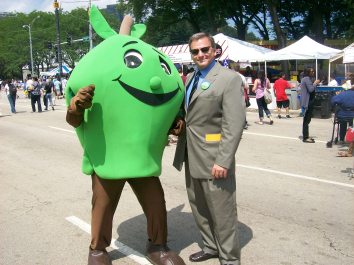Guest Blog: Humana Healthier Choices at Taste of Chicago
Posted: July 2, 2012 Filed under: Guest Blog, Kovler Team Members, Nutritional Tips | Tags: Amy Hess-Fischl, Chicago, food festival, Fredrik Tolin, Humana, Humana Healthier Choices, Humana of Illinois, kovler diabetes center, Taste of Chicago, The University of Chicago Leave a commentYou Can Eat at a Food Festival and Be Healthy, Too.
By Fredrik Tolin, M.D., medical director and vice president for Humana of Illinois
It’s officially summer – time to get outdoors and have fun! If you live in the Windy City or are planning a trip here, you’ll want to experience the annual Taste of Chicago – the biggest food festival in the U.S. For those of us who need to watch what we eat, though, food festivals can seem a bit scary. The temptations are endless and generally high in fat and calories.
Well, there is good news for Taste-goers. Health and wellness company, Humana, has again published the Humana Healthier Choices guide – and is bringing many health and well-being activities to the Taste of Chicago to help everyone enjoy the festival in a healthful way.
For the past two years, we have had the privilege of working with Amy Hess-Fischl, MS, RD, LDN, BC-ADM, CDE, advanced practice dietitian and coordinator for The University of Chicago Kovler Diabetes Center, to determine which foods made the cut to be listed as a Healthier Choice.
For a food to be considered, restaurants participating in the Taste of Chicago submit nutritional information including: calories, sodium content, saturated fat and the list of ingredients. Each submission is reviewed by a panel of top Chicago-area physicians with expertise in nutrition and diet, including Amy Hess-Fischl. The panel evaluates each submission to ensure they meet specific criteria: appetizers and desserts must contain less than 320 calories, 300 mg sodium and 2 g saturated fat; main dishes must contain 500 calories or less; 500 mg sodium or less; and less than 4 g saturated fat.
We’re thrilled to announce that this year’s guide boasts a record number of 27 healthier options – from salads to spicy sausage, flatbread to sorbet – offered from 15 Chicago restaurants! You can check out the full listing of Humana Healthier Choices online at www.humana.com/tasteofchicago, and if you feel compelled, please “like” our Facebook page, where you can receive updates on the various health and wellness events and activities Humana is offering at the festival July 11-15.
At the Taste of Chicago, the Humana Healthier Choices items will be indicated by a green apple on the menu boards at participating restaurant booths. While you’re enjoying all that Taste has to offer, take a minute to check out the Humana Dining Pavilion at Buckingham Fountain and the Humana Well-Being Tour for innovative, fun and healthy activities, including free dance lessons, exercise classes and even a sock-hop. And, of course, keep an eye out for the Humana Apple Man mascot to snap your picture!
I’d like to personally thank Amy Hess-Fischl and Kovler Diabetes Center for their continued support of our Humana Healthier Choices program. For more information about Humana’s offerings at the Taste of Chicago, please see our press release. We hope to see your there!
Enjoy the summer and stay well.
Guest Blog: Islet Cell Transplantation
Posted: June 20, 2012 Filed under: Guest Blog, Research and Grants, Transplantation | Tags: insulin, Islet Cell Transplant, kovler diabetes center, Lindsay Schenck, The University of Chicago, Type 1, type 1 diabetes, university of chicago medicine Leave a comment
Welcome to the wonderfully exiting world of research!
As the new Islet Cell Transplant Coordinator, I am new to Islet Cell transplant research and thought we could learn about it together.
Over in the Transplant Center at The University of Chicago we are researching the transplantation of islet cells from a deceased donor’s pancreas into a liver of the patient. Islet cells are the cells from the pancreas that produce insulin. First the Islet cells are isolated in a special solution, and then inserted into a liver vein much like any other solution. This is a non-invasive procedure.
Research on islet transplantation could be helpful for those with Type I to have better control of blood sugars. This research is currently being conducted in those with Type I who have trouble with low blood sugars, where they are no longer able to tell their sugar is too low during those light headed, shaky, wonky (yes, I think I made that word up) moments.
This research is being done in the transplant center because the islet cells that are used come from donated organs, just like a whole pancreas transplant. This research is similar to other studies that have been completed around the country and the world but applies the newest technology for better results.
To find out more about the islet cell transplant research check out the following websites: www.uchospitals.edu/specialties/transplant/pancreas-islet.html
www.citregistry.org
www.clinicaltrials.gov
Thank you,
Lindsay Schenck, RN, BSN
Islet Cell Transplant Coordinator
